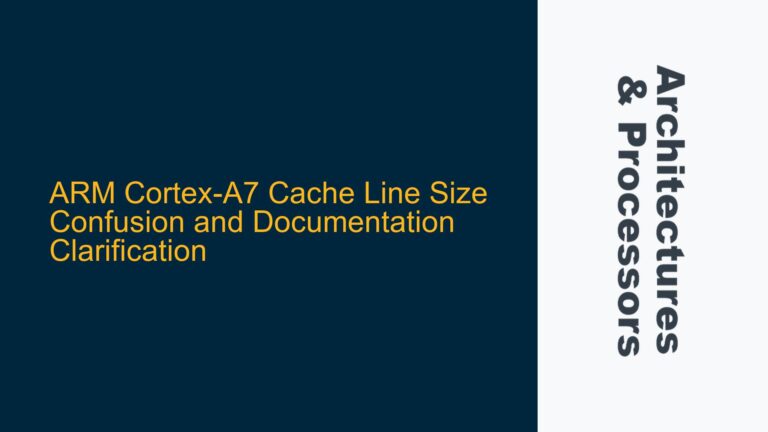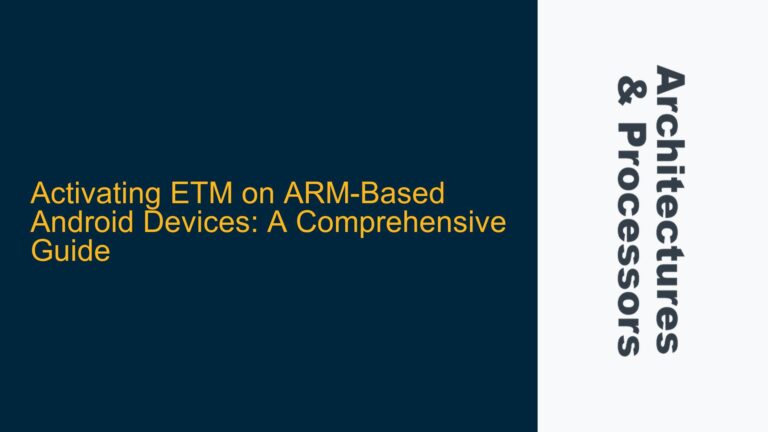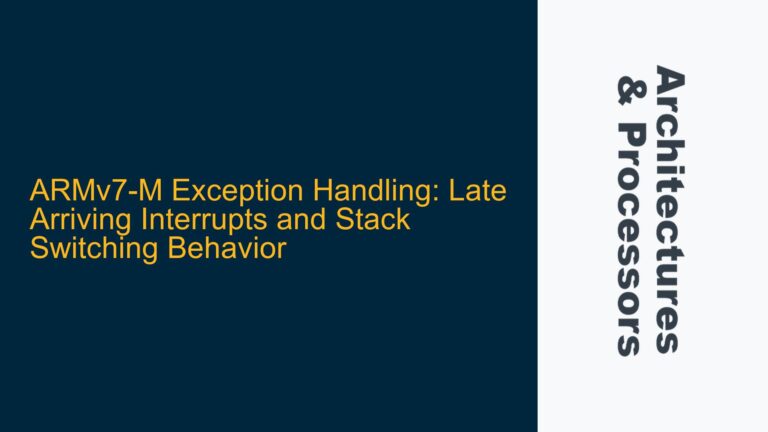ARMv8-A Stack Pointer Management: SP_EL1 Access Restrictions at EL1
In the ARMv8-A architecture, managing stack pointers (SP) across different exception levels (ELs) is a critical aspect of system software design. One of the key points of confusion arises when dealing with the stack pointer registers at EL1, specifically the distinction between directly accessing SP_EL1 and using the SPSEL register in combination with the MOV instruction. This post delves into the architectural nuances of stack pointer management, explaining why direct access to SP_EL1 is restricted at EL1 and how the SPSEL + MOV mechanism provides a workaround.
ARMv8-A Stack Pointer Registers and Their Accessibility
The ARMv8-A architecture defines multiple stack pointer registers, each associated with a specific exception level. For EL1, the primary stack pointer register is SP_EL1. However, the architecture imposes restrictions on how this register can be accessed, particularly when the processor is operating at EL1. According to the ARM Architecture Reference Manual (ARM ARM), direct writes to SP_EL1 using the MSR instruction are undefined when executed at EL1. This restriction is rooted in the architectural design to ensure proper isolation and security between exception levels.
The SP_EL1 register is intended to be used as the stack pointer when the processor is operating at EL1 or higher. However, when the processor is at EL1, the current stack pointer can be either SP_EL0 or SP_EL1, depending on the value of the SPSel bit in the PSTATE register. The SPSel bit determines which stack pointer is used: if SPSel is 0, the processor uses SP_EL0; if SPSel is 1, the processor uses SP_EL1.
Why Direct Access to SP_EL1 is Restricted at EL1
The restriction on directly writing to SP_EL1 at EL1 is a deliberate design choice in the ARMv8-A architecture. This restriction ensures that the stack pointer for EL1 can only be modified in a controlled manner, preventing potential security vulnerabilities and ensuring that the stack pointer is always in a valid state. Directly writing to SP_EL1 at EL1 could lead to unpredictable behavior, as the architecture does not guarantee the integrity of the stack pointer in such cases.
The ARM ARM explicitly states that the MSR SP_EL1, <Xt> instruction is undefined when executed at EL1. This means that attempting to write to SP_EL1 directly at EL1 will result in an undefined instruction exception. The rationale behind this restriction is to enforce a clear separation between the stack pointers used at different exception levels, thereby maintaining the integrity of the system’s stack management.
Using SPSEL + MOV to Modify SP_EL1 at EL1
While direct access to SP_EL1 is restricted at EL1, the architecture provides an alternative mechanism to modify the stack pointer: the SPSEL register in combination with the MOV instruction. This mechanism allows software to switch between SP_EL0 and SP_EL1 and modify the stack pointer in a controlled manner.
The process involves the following steps:
- Set the
SPSelbit to 1 using theMSR SPSel, #1instruction. This switches the current stack pointer toSP_EL1. - Use the
MOVinstruction to modify the stack pointer. For example,MOV SP, X0sets the current stack pointer (nowSP_EL1) to the value in registerX0. - Set the
SPSelbit back to 0 using theMSR SPSel, #0instruction. This switches the current stack pointer back toSP_EL0.
This approach ensures that the stack pointer is modified in a controlled and predictable manner, adhering to the architectural constraints of the ARMv8-A architecture.
Detailed Analysis of the SPSEL + MOV Mechanism
The SPSEL + MOV mechanism leverages the fact that the SPSel bit in the PSTATE register controls which stack pointer is currently in use. When SPSel is set to 1, the processor uses SP_EL1 as the current stack pointer, and any modifications to the stack pointer using the MOV instruction will affect SP_EL1. Conversely, when SPSel is set to 0, the processor uses SP_EL0 as the current stack pointer, and modifications to the stack pointer will affect SP_EL0.
This mechanism allows software to switch between SP_EL0 and SP_EL1 and modify the stack pointer without directly accessing the SP_EL1 register. By toggling the SPSel bit, software can ensure that the correct stack pointer is modified, maintaining the integrity of the stack management system.
Implications for Exception Handling and Context Switching
The ability to modify the stack pointer at EL1 using the SPSEL + MOV mechanism has important implications for exception handling and context switching. When an exception occurs, the processor automatically switches to the appropriate exception level and uses the corresponding stack pointer (SP_ELx). However, software may need to modify the stack pointer during exception handling or context switching to allocate additional stack space or switch to a different stack.
In such cases, the SPSEL + MOV mechanism provides a safe and controlled way to modify the stack pointer without violating the architectural constraints of the ARMv8-A architecture. This ensures that the stack pointer is always in a valid state, preventing potential security vulnerabilities and ensuring the reliability of the system.
Best Practices for Stack Pointer Management at EL1
Given the architectural constraints and the mechanisms available for modifying the stack pointer at EL1, the following best practices are recommended:
- Avoid Direct Access to SP_EL1 at EL1: Directly writing to
SP_EL1at EL1 is undefined and should be avoided. Instead, use theSPSEL+MOVmechanism to modify the stack pointer in a controlled manner. - Use SPSEL to Switch Between Stack Pointers: When modifying the stack pointer at EL1, always use the
SPSELregister to switch betweenSP_EL0andSP_EL1. This ensures that the correct stack pointer is modified and maintains the integrity of the stack management system. - Ensure Proper Synchronization: When modifying the stack pointer, ensure that the changes are properly synchronized with the rest of the system. This may involve using memory barriers or other synchronization mechanisms to prevent race conditions and ensure the consistency of the stack pointer.
- Validate Stack Pointer Values: Before modifying the stack pointer, validate the new value to ensure that it points to a valid and accessible memory region. This prevents potential issues such as stack overflow or accessing invalid memory locations.
Conclusion
The ARMv8-A architecture provides a robust and secure framework for managing stack pointers across different exception levels. While direct access to SP_EL1 is restricted at EL1, the SPSEL + MOV mechanism provides a safe and controlled way to modify the stack pointer. By adhering to the architectural constraints and following best practices, software can ensure the reliability and security of the stack management system in ARMv8-A-based systems.
Understanding the nuances of stack pointer management at EL1 is crucial for developing robust and secure system software. By leveraging the SPSEL + MOV mechanism and adhering to best practices, developers can effectively manage stack pointers in ARMv8-A systems, ensuring the integrity and reliability of their software.






